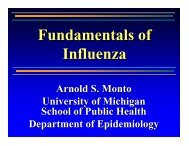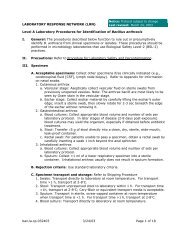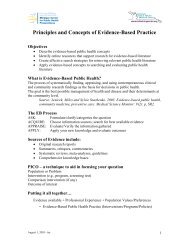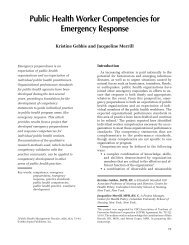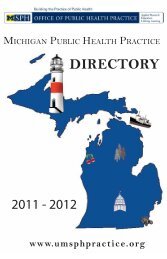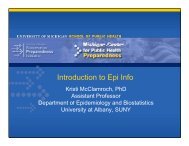Crosswalk - Office of Public Health Practice - University of Michigan
Crosswalk - Office of Public Health Practice - University of Michigan
Crosswalk - Office of Public Health Practice - University of Michigan
- No tags were found...
Create successful ePaper yourself
Turn your PDF publications into a flip-book with our unique Google optimized e-Paper software.
<strong>Crosswalk</strong>Prepared byMary Lynn Kushion, MSAforAn analysis <strong>of</strong> PHAB standards and <strong>Michigan</strong>local public health accreditationrequirements<strong>Office</strong> <strong>of</strong> <strong>Public</strong> <strong>Health</strong> <strong>Practice</strong><strong>University</strong> <strong>of</strong> <strong>Michigan</strong>School <strong>of</strong> <strong>Public</strong> <strong>Health</strong>August 2011
Contact InformationAuthorMary Kushion, MSA<strong>Health</strong> <strong>Office</strong>rCentral <strong>Michigan</strong> District <strong>Health</strong> Departmentmkushion@cmdhd.orgFUNDER<strong>Michigan</strong> <strong>Public</strong> <strong>Health</strong> Training Center<strong>Office</strong> <strong>of</strong> <strong>Public</strong> <strong>Health</strong> <strong>Practice</strong><strong>University</strong> <strong>of</strong> <strong>Michigan</strong> School <strong>of</strong> <strong>Public</strong> <strong>Health</strong>1415 Washington HeightsAnn Arbor, MI 48109‐2029mphtc@umich.edu© 2011 by the Regents <strong>of</strong> the <strong>University</strong> <strong>of</strong> <strong>Michigan</strong>Appendix 1: Accreditation for Local <strong>Public</strong> <strong>Health</strong>: A Comparison <strong>of</strong> the <strong>Michigan</strong> Local <strong>Public</strong> <strong>Health</strong> AccreditationProgram (MLPHPAP) and the National <strong>Public</strong> <strong>Health</strong> Accreditation Program (PHAB) GREEN PAPER is used bypermission <strong>of</strong> Debra Scarmarchia Tews, MA, Accreditation & Quality Improvement Manager, <strong>Michigan</strong> Department<strong>of</strong> Community <strong>Health</strong> Local <strong>Health</strong> Services.
Table <strong>of</strong> ContentsIntroduction ............................................................................................................................ 1Author ..................................................................................................................................... 2Disclaimer ............................................................................................................................... 3<strong>Crosswalk</strong> Format .................................................................................................................... 3<strong>Crosswalk</strong>: <strong>Michigan</strong> and National Voluntary <strong>Public</strong> <strong>Health</strong> Accreditation ................................. 5Domain 1: Conduct and disseminate assessments focused on population health status andpublic health issues facing the community ........................................................................... 5Domain 2: Investigate health problems and environmental public health hazards to protectthe community ....................................................................................................................... 7Domain 3: Inform and educate about public health issues and functions ................................ 9Domain 4: Engage with the community to identify and address health problems ................. 11Domain 5: Develop public health policies and plans ................................................................ 12Domain 6: Enforce public health laws ...................................................................................... 13Domain 7: Promote strategies to improve access to health care services .............................. 15Domain 8: Maintain a competent public health workforce ..................................................... 16Domain 9: Evaluate and continuously improve processes, programs, and interventions ....... 17Domain 10: Contribute to and apply the evidence base <strong>of</strong> public health ............................... 18Domain 11: Maintain administrative and management capacity ............................................. 19Domain 12: Maintain capacity to engage the public health governing entity .......................... 20Appendix 1Accreditation for Local <strong>Public</strong> <strong>Health</strong>: A Comparison <strong>of</strong> the <strong>Michigan</strong> Local <strong>Public</strong> <strong>Health</strong>Accreditation Program (MLPHPAP) and the National <strong>Public</strong> <strong>Health</strong> Accreditation Program(PHAB) GREEN PAPER.Green paper Prepared By: Debra Scarmarcia Tews, MA, Accreditation & Quality Improvement Manager,<strong>Michigan</strong> Department <strong>of</strong> Community <strong>Health</strong> Local <strong>Health</strong> Services, June 7, 2010 (Rev. 7/8/10, 8/31/10)
[This page left intentionally blank.]
Introduction<strong>Public</strong> health accreditation is a status that provides public notification that the public healthdepartment or program meets standards <strong>of</strong> quality set forth by an accrediting body. <strong>Public</strong>health accreditation demonstrates accountability to the community and measures performanceagainst established standards.In <strong>Michigan</strong>, public health accreditation for local public health departments (LHDs) wasembodied in the <strong>Michigan</strong> Local <strong>Public</strong> <strong>Health</strong> Accreditation Program (MLPHAP) 1 . The MLPHAP,formed in 1998, is a collaboration <strong>of</strong> <strong>Michigan</strong>’s state departments <strong>of</strong> Agriculture and RuralDevelopment, Community <strong>Health</strong>, and Environmental Quality, the <strong>Michigan</strong> <strong>Public</strong> <strong>Health</strong>Institute, the <strong>Michigan</strong> Association for Local <strong>Public</strong> <strong>Health</strong>, and <strong>Michigan</strong>’s local public healthdepartments. The purpose <strong>of</strong> MLPHAP is to monitor and evaluate <strong>Michigan</strong>’s 45 local healthdepartments for compliance with an established set <strong>of</strong> Minimum Program Requirements(MPRs). This MPR set is based on law, statute, or administrative rule for 13program/administrative functions. <strong>Michigan</strong>’s local health departments receive an on‐sitereview every three years. In 2011, <strong>Michigan</strong> is in the process <strong>of</strong> completing Cycle 4, its 4 thaccreditation cycle. Cycle 5 will begin in 2012.A national voluntary public health accreditation program was launched in July 2011 under theauspices <strong>of</strong> the <strong>Public</strong> <strong>Health</strong> Accreditation Board (PHAB). PHAB receives support from theCenters for Disease Control and Prevention (CDC) and The Robert Wood Johnson Foundation(RWJF), and works closely with national organizations, such as the National Association <strong>of</strong>County & City <strong>Health</strong> Officials (NACCHO), the Association <strong>of</strong> State and Territorial <strong>Health</strong> Officials(ASTHO), the National Association <strong>of</strong> Local Boards <strong>of</strong> <strong>Health</strong> (NALBOH), the National Indian<strong>Health</strong> Board, and APHA (American <strong>Public</strong> <strong>Health</strong> Association). PHAB’s national accreditationprogram is based on the 10 essential public health services and also includes Administrative andManagement Capacity and Capacity to Engage the <strong>Public</strong> <strong>Health</strong> Governing Authority. 2 Version1.0 is the initial release <strong>of</strong> its domains, standards and measures for the voluntary nationalaccreditation review for state, local, and tribal health departments. 3To aid in understanding how <strong>Michigan</strong>’s ongoing state‐wide accreditation work may be used tosupport and assist in meeting national voluntary accreditation through PHAB, the <strong>Michigan</strong><strong>Public</strong> <strong>Health</strong> Training Center, which is housed in the <strong>University</strong> <strong>of</strong> <strong>Michigan</strong> School <strong>of</strong> <strong>Public</strong><strong>Health</strong>’s <strong>Office</strong> <strong>of</strong> <strong>Public</strong> <strong>Health</strong> <strong>Practice</strong>, commissioned a <strong>Crosswalk</strong> <strong>of</strong> the two programs in2011. The goal <strong>of</strong> this <strong>Crosswalk</strong> is to take each <strong>of</strong> the 12 PHAB standards and identify relevant1 <strong>Michigan</strong> Local <strong>Public</strong> <strong>Health</strong> Accreditation Program www.accreditation.localhealth.net2 <strong>Public</strong> <strong>Health</strong> Accreditation Board www.phaboard.org3 <strong>Public</strong> <strong>Health</strong> Accreditation Board www.phaboard.org<strong>Crosswalk</strong>: <strong>Michigan</strong> and National Voluntary <strong>Public</strong> <strong>Health</strong> Accreditation page 1
standards within the MLPHAP, indicate their applicability and point out current documentationefforts being done for MLPHAP that may serve national accreditation standards. This <strong>Crosswalk</strong>is a tool for <strong>Michigan</strong>’s local public health departments, as they work toward applying fornational public health accreditation.Given how recently the launch <strong>of</strong> national voluntary accreditation occurred—July 1, 2011—this<strong>Crosswalk</strong> should be viewed as a work‐in‐progress, subject to updates and additions. Readerscan benefit from the documentation examples identified here and, hopefully, will contributetheir own examples <strong>of</strong> how work done under the <strong>Michigan</strong> accreditation process also fits withinthe framework <strong>of</strong> the national voluntary accreditation program.An accreditation green paper was written by <strong>Michigan</strong> Department <strong>of</strong> Community <strong>Health</strong>(MDCH) Local <strong>Health</strong> Services Manager Debra Tews in 2010 and provides an overview <strong>of</strong><strong>Michigan</strong>’s public health accreditation program and PHAB’s program, which was in beta test atthat time. The green paper is contained in Appendix 1 <strong>of</strong> the <strong>Crosswalk</strong>.AuthorThe <strong>Crosswalk</strong> was developed by Mary Lynn Kushion and represents her depth <strong>of</strong> knowledgewith both MLPHAP and the PHAB’s national voluntary public health accreditation program. Herblend <strong>of</strong> expertise and national, state and local experiences make her uniquely qualified toreflect on the two sets <strong>of</strong> standards and produce a <strong>Crosswalk</strong>.Ms. Kushion is the <strong>Health</strong> <strong>Office</strong>r <strong>of</strong> the Central <strong>Michigan</strong> District <strong>Health</strong> Department; aposition she has held since January 1993. Ms. Kushion had led her department through fouraccreditation cycles including the voluntary Quality Improvement Supplement (QIS) containedwithin the MLPHAP Powers and Duties section.In 2003, Ms. Kushion was asked to chair the <strong>Michigan</strong> Accreditation Quality Improvement(AQIP) Workgroup, a sub‐committee <strong>of</strong> the <strong>Michigan</strong> Local <strong>Public</strong> <strong>Health</strong> AccreditationCommission. The charge for the AQIP Workgroup is to ensure that improvement activitiesassociated with <strong>Michigan</strong>’s accreditation process engage all key stakeholders, to identifyopportunities for process improvement and to develop recommendations for ongoing processimprovement. Ms. Kushion has also been a member <strong>of</strong> the <strong>Michigan</strong> Local <strong>Public</strong> <strong>Health</strong>Accreditation Commission since 2006.Ms. Kushion was a member <strong>of</strong> the Research and Evaluation Team for Exploring Accreditation,an RWJ‐funded project that provided final recommendations in 2006 for a voluntary nationalaccreditation program for state and local public health departments. She was also selected toserve as a member <strong>of</strong> the PHAB Standards Development Workgroup. In 2010 Ms. Kushionserved as a member on two PHAB beta test site visits.<strong>Crosswalk</strong>: <strong>Michigan</strong> and National Voluntary <strong>Public</strong> <strong>Health</strong> Accreditation page 2
Ms. Kushion has also served on the NACCHO <strong>Public</strong> <strong>Health</strong> Infrastructure Workgroup and iscurrently the chairperson <strong>of</strong> the NACCHO Accreditation Preparation and Quality ImprovementWorkgroup.DisclaimerIt is the author’s belief that this report and its documentation examples may support and assistthe reader in meeting standards within the PHAB process. The author does not make anyguarantees that what is referenced in this report as suggested evidence to meet the PHABstandards will actually satisfy PHAB reviewers; the information is being provided as suggestionsonly.<strong>Crosswalk</strong> FormatThe <strong>Crosswalk</strong> includes: PHAB Version 1.0 domains and standards. All 12 PHAB domains are included. An indication <strong>of</strong> whether or not the standard is also measured within <strong>Michigan</strong>’s systemutilizing the minimum program requirements in the Cycle 4 tool. Suggestions for how local health departments within the state <strong>of</strong> <strong>Michigan</strong> may be ableto potentially meet the PHAB standards with documentation/evidence currentlyrequired to meet the minimum program requirements in MLPHAP. Evidence ordocumentation examples drawn from the <strong>Michigan</strong> Accreditation Program, Cycle 4,where available.The <strong>Crosswalk</strong> does not address the individual PHAB measures within standards; thecomparisons between the two accreditation systems are presented at the PHABStandard/MLHAP MPR level. Furthermore, the <strong>Crosswalk</strong> does not give all <strong>of</strong> the possibledocumentation necessary to meet the PHAB standards as they are contained in the PHABVersion 1.0 Standards and Measures, but rather gives examples to give the reader an idea <strong>of</strong>the types <strong>of</strong> documentation required. The elements and requirements contained as acomponent <strong>of</strong> the Powers and Duties Section were included in the <strong>Crosswalk</strong> and arereferenced as the Plan <strong>of</strong> Organization, 4 which is a document all local health departments in<strong>Michigan</strong> are required to submit to MDCH for approval every three years and the approvedplan is necessary to meet Powers and Duties indicator 1.6.4 The Plan <strong>of</strong> Organization is a <strong>Michigan</strong> <strong>Public</strong> <strong>Health</strong> Code Requirement for all local health departments which isreviewed and approved by the <strong>Michigan</strong> Department <strong>of</strong> Community <strong>Health</strong> once every three years. It includes theagency’s legal responsibilities, organizational structure, mission, collaborative initiatives, service delivery,evaluation and health <strong>of</strong>ficer and medical director qualifications. The Plan <strong>of</strong> Organization can be found athttp://www.michigan.gov/documents/mdch/Plan<strong>of</strong>OrganizationPackage3_5_07_189023_7.doc<strong>Crosswalk</strong>: <strong>Michigan</strong> and National Voluntary <strong>Public</strong> <strong>Health</strong> Accreditation page 3
[This page left intentionally blank.]<strong>Crosswalk</strong>: <strong>Michigan</strong> and National Voluntary <strong>Public</strong> <strong>Health</strong> Accreditation page 4
Domain 1: Conduct and disseminate assessments focused on population health status and public health issuesfacing the communityPHAB Standards(Version 1.0)1.1 Participate In orConduct aCollaborativeProcess Resultingin aComprehensiveCommunity <strong>Health</strong>Assessment1.2 Collect andMaintain Reliable,Comparable, andValid Data ThatProvideInformation onConditions <strong>of</strong><strong>Public</strong> <strong>Health</strong>Importance andOn the <strong>Health</strong>Status <strong>of</strong> thePopulation<strong>Michigan</strong> Accreditation Program Indicators(Cycle 4)Not addressed in <strong>Michigan</strong>’s Cycle 4 process.Many local health departments (LHD) in <strong>Michigan</strong>participate in community health assessments, butbecause it is not a state mandate and does not receivestate funding, it is not included in the accreditationprocess.MI accreditation sections contain specific examples <strong>of</strong>the types <strong>of</strong> data collected. Examples are cited asfollows:Section 1 Powers and Duties 1.2 (a &b): Demonstrateaccess to vital health statistics. Documents thatdemonstrates analysis and interpretation <strong>of</strong> vitalstats.Section 1 Powers and Duties 1.3 LHD shall makeinvestigations as to causes <strong>of</strong> disease, morbidity andmortality as well as environmental hazards.Plan <strong>of</strong> Organization 2.DSection 3 Food Service 7 Identify critical violationsduring field review.Section 4 Communicable Disease (CD) 1.2 Collects CDdataSection 4 CD 1.4 Data on annual reportSection 5 Hearing 1.2 Documentation <strong>of</strong> hearingscreenings between ages <strong>of</strong> 3‐5Section 5 Hearing 2.1 Report stats <strong>of</strong> Hearing screeningsin public and private schools.Section 6 Immunizations (Imms). 4.1 LHD shall sustainimmunization levels in <strong>Michigan</strong> ChildhoodImmunization Registry (MCIR)Section 7 On‐Site Sewage 5.1 Documentation on systemfailures and why they occurred.Section 8 Sexually Transmitted Disease (STD) 1.1 Ensurereporting and follow‐up with <strong>Michigan</strong>’s <strong>Public</strong> <strong>Health</strong>CodeSection 9 Vision 1.2 Documentation <strong>of</strong> Vision screeningsfor children 3‐5.Section 9 Vision 2.1 Program reports that show LHDassured vision screenings for school age children.Section 12 HIV/AIDS 1.1 and 1.2 Conduct reporting andfollow‐up <strong>of</strong> HIV/AIDS cases.Meeting PHAB Standards:Evidence/Documentation ExamplesLHDs who have not yet begun acommunity health assessment processare encouraged to work with local nonpr<strong>of</strong>ithospitals that are mandated tocomplete a community healthassessment process.A completed community healthassessment report.PHAB will require evidence <strong>of</strong>partnerships/training/utilization <strong>of</strong>surveillance sites. Agencies need toshow evidence <strong>of</strong> where the surveillancesites are located and the types <strong>of</strong>meetings/trainings held with the sites.Documentation on general populationhealth data and its availability will berequired. Website screen shots, annualreports, press releases, county healthrankings data are possible examples.<strong>Crosswalk</strong>: <strong>Michigan</strong> and National Voluntary <strong>Public</strong> <strong>Health</strong> Accreditation page 5
Domain 1: Conduct and disseminate assessments focused on population health status and public health issuesfacing the communityPHAB Standards(Version 1.0)1.3 Analyze <strong>Public</strong><strong>Health</strong> Data toidentify Trends in<strong>Health</strong> Problems,Environmental<strong>Public</strong> <strong>Health</strong>Hazards, and Socialand EconomicFactors That Affectthe <strong>Public</strong>’s <strong>Health</strong>1.4 Provide and Usethe Results <strong>of</strong><strong>Health</strong> DataAnalysis toDevelopRecommendationsRegarding <strong>Public</strong><strong>Health</strong> Policy,Processes,Programs, orInterventions<strong>Michigan</strong> Accreditation Program Indicators(Cycle 4)<strong>Michigan</strong>’s indicators do not specifically include analysis<strong>of</strong> social and economic conditions, but rather focus onhealth problems and hazards.Section 1 Powers and Duties 1.2 (a & b) Demonstrateaccess to vital health statistics. Documents thatdemonstrates analysis and interpretation <strong>of</strong> vitalstats.Section 1 Powers and Duties 1.3 LHD shall makeinvestigations as to causes <strong>of</strong> disease, morbidity andmortality as well as environmental hazards.Section 4 CD 1.2 Collects/analyzes data.Section 7 On‐Site Sewage 5.1 Documentation on systemfailures and why they occurred.Section 8 STD 3 Analyze STD morbidity priority reportingsites and provide pr<strong>of</strong>essional attention to those sites.Not addressed in <strong>Michigan</strong> Cycle 4 process, but twoexamples are listed here on how data collected to meetthe MLPHAP may be used to meet the PHAB standard.Section 6 Imms. 6.1 LHD uses the IAP mechanism toimprove immunization rates, clinic hours and tocoordinate services/communication with private/publicprovidersSection 8 STD 3.1 Analyze STD morbidity priorityreporting sites and provide pr<strong>of</strong>essional attention tothose sites.Meeting PHAB Standards:Evidence/Documentation ExamplesExamples include informationdistributed to various audiences on thestatus <strong>of</strong> health behaviors, and/orenvironmental issues in order to informthe public on the health status <strong>of</strong> thecommunity. Evidence needs to showthat the information contained in thereport was distributed and how it wasdistributed, but does not necessarilyneed to include the report itself.Utilize the reports generated in PHABStandard 1.3; use the information in thereports to form county health pr<strong>of</strong>ilesand show evidence <strong>of</strong> how they weredistributed to community stakeholdersand the public through the use <strong>of</strong>website screen shots, emaildistributions, press releases,presentations.<strong>Crosswalk</strong>: <strong>Michigan</strong> and National Voluntary <strong>Public</strong> <strong>Health</strong> Accreditation page 6
Domain 2: Investigate health problems and environmental public health hazards to protect the communityPHAB Standards(Version 1.0)2.1 Conduct TimelyInvestigations <strong>of</strong><strong>Health</strong> ProblemsandEnvironmental<strong>Public</strong> <strong>Health</strong>Hazards2.2 Contain/Mitigate <strong>Health</strong>Problems andEnvironmental<strong>Public</strong> <strong>Health</strong>Hazards2.3 Ensure Access toLaboratory andEpidemiologic/Environmental <strong>Public</strong><strong>Health</strong> Expertiseand Capacity toInvestigate andContain/Mitigate<strong>Public</strong> <strong>Health</strong>Problems andEnvironmental<strong>Public</strong> <strong>Health</strong>Hazards<strong>Michigan</strong> Accreditation Program Indicators(Cycle 4)Section 1 Powers and Duties 1.2 LHD shall utilize healthstats for purposes <strong>of</strong> protecting the public’s health.Section 4 CD 1.2 Collects/analyzes data.Section 3 Food Service 7 Citing <strong>of</strong> critical violations duringfield review.Section 3 Food Service 8 Food Code complaintinspections are conducted.Prevention <strong>of</strong> public health disasters outside <strong>of</strong>communicable disease and/or food borne outbreaks arenot addressed in <strong>Michigan</strong>’s accreditation process inCycle 4.Section 3 Food Service 10 Enforcement <strong>of</strong> food codeviolationsSection 3 Food Service 11 Unauthorized construction <strong>of</strong>food facilitiesSection 3 Food Service 14 Variances are reviewed forconditions that vary from the codeSection 3 Food Service 15 Complaint investigations aredone when reported.Section 4 CD 2.1 Initiate CD investigations required by<strong>Michigan</strong> law and executive ordersSection 2 Clinical Lab 1.1 LHD acts in accordance with theClinical Lab Improvement Amendment <strong>of</strong> 2003.Section 4 CD 1.3 Submit to MDCH.Section 4 CD 1.2 Collects data from labs, etc.Meeting PHAB Standards:Evidence/Documentation ExamplesCommunicable Disease/Food BorneOutbreak Policies/Protocols withreporting timelines and staffresponsibilities included in the policy(can be hard copy or availableelectronically).Examples <strong>of</strong> disease/environmentalhealth investigations conducted by theagency.After Action reports, results <strong>of</strong> foodservice investigation. Epidemiologicalreport sent to state withfindings/recommendations andconclusions.List <strong>of</strong> significant events within thejurisdiction and what promptsactivation <strong>of</strong> the All‐Hazard Plan.CLIA certificate, evidence <strong>of</strong> access tolab services 24/7, protocols for handlingspecimens.24/7 Call down lists and documentationthat it has been tested.Assurance <strong>of</strong> 24/7 coverage and surgecapacity.<strong>Crosswalk</strong>: <strong>Michigan</strong> and National Voluntary <strong>Public</strong> <strong>Health</strong> Accreditation page 7
Domain 2: Investigate health problems and environmental public health hazards to protect the communityPHAB Standards(Version 1.0)2.4 Maintain a Planwith Policies andProcedures forUrgent and Non‐UrgentCommunications<strong>Michigan</strong> Accreditation Program Indicators(Cycle 4)Although this happens routinely throughout the state,emergency preparedness is not currently included in<strong>Michigan</strong>’s accreditation process. The examples cited inthis section relate to communications between the stateand local health departments to communicate specificdisease/program indicators.Plan <strong>of</strong> Organization 2.d IT capacity available to accessand distribute current public health information.Section 4 CD 2.3 Notify MDCH immediately if suspect CDin jurisdictionSection 4 CD 1.1, 2.1, 3.1, and 4.1 Policies andprocedures for CD reportingSection 4 CD 1.3 CD case reports submitted electronicallyvia MDSS (technology)Section 6 Imms 4.3 LHD submits immunization reports tothe MCIRSection 6 Imms 4.1 LHD conforms to on‐line reportingrequirementsSection 6 Imms 4.2 LHD uses web‐based reporting toassure accurate school records.Section 8 STD 5 Submission <strong>of</strong> quarterly STD medicationinventory report to MDCH.Section 12 HIV/AIDS 2.3 Maintain necessarytechnological capacity.Meeting PHAB Standards:Evidence/Documentation ExamplesAgency Risk Communications PlanMedia Relations PlanParticipation and use <strong>of</strong> <strong>Health</strong> AlertNetwork (HAN)Evidence that the media was usedduring a public health emergencyEvidence <strong>of</strong> joint exercises with stateand Tribal partners<strong>Crosswalk</strong>: <strong>Michigan</strong> and National Voluntary <strong>Public</strong> <strong>Health</strong> Accreditation page 8
Domain 3: Inform and educate about public health issues and functionsPHAB Standards(Version 1.0)3.1 Provide <strong>Health</strong>Education and<strong>Health</strong> PromotionPolicies,Programs,Processes, andInterventions toSupportPrevention andWellness<strong>Michigan</strong> Accreditation Program Indicators(Cycle 4)Section 1 Powers and Duties 1.4 A local healthdepartment shall plan, implement, and evaluate healtheducation through the provision <strong>of</strong> expert technicalassistance, or financial support, or both.Section 1 Powers and Duties 1.7 LHD shall plan,implement and evaluate nutrition services.Section 3 Food Service. Important Factor I Addresseseducational outreach activities such as newsletters,website, training, etc.Section 4 CD 1 – General definition‐ The local healthdepartment must have a system in place that allowsfor the referral <strong>of</strong> disease incidence and reportinginformation from physicians, laboratories, and otherreporting entities to the local health department.Section 5 Hearing 6 A local health department shallconduct periodic free hearing programs for the testingand screening <strong>of</strong> children residing in its jurisdiction.The time and place <strong>of</strong> the programs shall be publicized.Section 9 Vision 6A Local health department shallconduct periodic free vision programs for the testingand screening <strong>of</strong> children residing in its jurisdiction.The time and place <strong>of</strong> the programs shall be publicized.Section 11 Family Planning 10.2 The agency must have anInformation and Education (I & E) committee to reviewand approve all informational and educationalmaterials developed or made available by the project.Section 12 HIV/AIDS 7 Establish, maintain and documentlinkages with community resources that are necessaryand appropriate to addressing the prevention and careneeds <strong>of</strong> clients receiving HIV‐related services.Meeting PHAB Standards:Evidence/Documentation ExamplesExamples <strong>of</strong> press releases, annualreports, presentations, flyers, brochureswhich address health issues, risks,behaviors, prevention or wellness andhow they were shared with public.Meeting minutes from advisory councilsregarding the formation <strong>of</strong> messaging.<strong>Crosswalk</strong>: <strong>Michigan</strong> and National Voluntary <strong>Public</strong> <strong>Health</strong> Accreditation page 9
Domain 3: Inform and educate about public health issues and functionsPHAB Standards(Version 1.0)3.2 ProvideInformation on<strong>Public</strong> <strong>Health</strong>Issues and <strong>Public</strong><strong>Health</strong> FunctionsThrough MultipleMethods to aVariety <strong>of</strong>Audiences<strong>Michigan</strong> Accreditation Program Indicators(Cycle 4)Section 1 Powers and Duties 1.4 LHD plans, implementsand evaluates health education through provision <strong>of</strong>tech. assist/financial support.Powers and Duties Plan <strong>of</strong> Organization 3 Contains aclear, formally written, publicized statement <strong>of</strong> thedepartment’s mission (may include Vision, Values,Goals, Objectives).Section 3 Food Service Important Factor I Addresseseducational outreach activities such as newsletters,website, training, etc.Section 6 Imms 1.4 LHD sends recalls to children not upto date.Section 11 Family Planning 13 Provide informational andeducational programs.Section 12 HIV/AIDS 8 Perform activities necessary tocontrol the spread <strong>of</strong> HIV infection.Meeting PHAB Standards:Evidence/Documentation ExamplesExamples <strong>of</strong> how the health departmentcommunicates its existence, mission,vision and role/ presence to thecommunity such as through use <strong>of</strong> logoon brochures, clothing, signage, flyers,etc.Agency written communication planwith evidence <strong>of</strong> annual updating <strong>of</strong>contacts (media, partners).Media Contact listWebsite/page with 24/7 emergencycontact number, health data, links topublic health laws and reportableconditions contact numberList <strong>of</strong> contractors for translation,interpretation and communicationserviceExamples <strong>of</strong> culturally appropriatematerialsUse <strong>of</strong> Facebook and Twitter ascommunication tools<strong>Crosswalk</strong>: <strong>Michigan</strong> and National Voluntary <strong>Public</strong> <strong>Health</strong> Accreditation page 10
Domain 4: Engage with the community to identify and address health problemsPHAB Standards(Version 1.0)4.1 Engage with the<strong>Public</strong> <strong>Health</strong>System and theCommunity inIdentifying andAddressing <strong>Health</strong>Problems ThroughCollaborativeProcesses<strong>Michigan</strong> Accreditation Program Indicators(Cycle 4)Identified in Plan <strong>of</strong> Organization rather than inaccreditation process.Plan <strong>of</strong> Organization Section 4 – Local planning andcollaboration initiatives.Meeting PHAB Standards:Evidence/Documentation ExamplesExamples <strong>of</strong> coalitions where publichealth is an active participant, such asTobacco Reduction, Complete Streets,<strong>Health</strong>y Kids ‐ meeting minutes, emails.Documentation through emails,newsletters etc. on communityengagement models and how they wereshared with community partners4.2 Promote theCommunity’sUnderstanding <strong>of</strong>and Support forPolicies andStrategies Thatwill Improve the<strong>Public</strong>’s <strong>Health</strong>Not addressed in Cycle 4 process.Examples (press releases,presentations) given to the communityand/or governing board on howpolicies/laws will impact/improve publichealth.<strong>Crosswalk</strong>: <strong>Michigan</strong> and National Voluntary <strong>Public</strong> <strong>Health</strong> Accreditation page 11
Domain 5: Develop public health policies and plansPHAB Standards(Version 1.0)5.1 Serve as aPrimary andExpert Resourcefor Establishingand Maintaining<strong>Public</strong> <strong>Health</strong>Policies, <strong>Practice</strong>sand Capacity<strong>Michigan</strong> Accreditation Program Indicators(Cycle 4)Identified in Plan <strong>of</strong> Organization rather than inaccreditation process.Plan <strong>of</strong> Organization – Section 4 Local Planning andCollaboration Initiatives.Meeting PHAB Standards:Evidence/Documentation ExamplesExamples <strong>of</strong> presentations given onpublic health to board, legislature,community groupsParticipation on <strong>Michigan</strong> Associationfor Local <strong>Public</strong> <strong>Health</strong> (MALPH) listserves and meetings where publichealth issues/laws/policies arediscussed.5.2 Conduct aComprehensivePlanning ProcessResulting in aTribal/State/Community <strong>Health</strong>Improvement PlanNot addressed in Cycle 4 process.Evidence that health department hascollaborated with hospitals andcommunity partners to develop acommunity health improvement plan (aPHAB pre‐requisite) Meeting minutes,emails reports.Examples <strong>of</strong> how the plan wasimplemented, evaluated and revised5.3 Develop andImplement a<strong>Health</strong>DepartmentOrganizationalStrategic PlanIdentified in Plan <strong>of</strong> Organization rather than inaccreditation process.Plan <strong>of</strong> Organization – Section 3 Mission, Vision andValues – Contains a clear statement <strong>of</strong> LHD’s mission,vision, values, goals and objectives.Agency strategic plan (a PHAB prerequisite).Annual progress reports5.4 Maintain an AllHazardsEmergencyOperations PlanNot addressed in Cycle 4 process; however it is amandated document from the <strong>Office</strong> <strong>of</strong> <strong>Public</strong> <strong>Health</strong>Preparedness (MDCH).Evidence <strong>of</strong> an All‐Hazards Plan thatincludes roles and responsibilities <strong>of</strong>partners in an emergency.Evidence <strong>of</strong> testing and revisions to theplanEvidence <strong>of</strong> an agency EmergencyOperations Plan<strong>Crosswalk</strong>: <strong>Michigan</strong> and National Voluntary <strong>Public</strong> <strong>Health</strong> Accreditation page 12
Domain 6: Enforce public health lawsPHAB Standards(Version 1.0)6.1 Review ExistingLaws and Workwith GoverningEntities andElected/AppointedOfficials to Updateas Needed<strong>Michigan</strong> Accreditation Program Indicators(Cycle 4)The MLPHAP does not specifically require a review <strong>of</strong>existing laws, and does not address working withgoverning entities but does have several sections whereevidence <strong>of</strong> enforcement is required. Examples <strong>of</strong> theserequirements are as follows and included in PHAB 6.3:Section 1 Powers and Duties 1.1 LHD enforces lawsvested in the LHD.Section 1 Powers and Duties 1.6 Plan <strong>of</strong> Organizationadopted by local governing entity and approved byMDCH.Meeting PHAB Standards:Evidence/Documentation ExamplesMeeting minutes from board <strong>of</strong>health/county/city commissionmeetings regarding public health lawsand enforcement <strong>of</strong> them.Examples within <strong>Michigan</strong> include theSmoke Free Air law, licensing <strong>of</strong> bodyart facilities, the food code and localsanitary code.Evidence that laws have been reviewedand evaluated for consistency withpublic health evidence‐based and/orpromising practices.6.2 EducateIndividuals andOrganizations Onthe Meaning,Purpose,Compliance, andBenefit <strong>of</strong> <strong>Public</strong><strong>Health</strong> Laws andHow to ComplySection 3 Food Service Important Factor 1 Educationaloutreach to educate public.Section 3 Food Service 16, 17 and 18 Technical, field andspecialty food training all required for inspection staff.Section 4 CD 3.3 Adequately prepared staff capable <strong>of</strong>enforcing MI law for control <strong>of</strong> CD.Staff training logs, conferenceattendance documents pertaining totraining on public health laws.Availability <strong>of</strong> laws on websiteEvidence that laws have beencommunicated to individuals andentities required to abide by them.Examples may include public schoolsthat have to enforce immunizationrequirements and restaurants that needto abide by food code laws.<strong>Crosswalk</strong>: <strong>Michigan</strong> and National Voluntary <strong>Public</strong> <strong>Health</strong> Accreditation page 13
Domain 6: Enforce public health lawsPHAB Standards(Version 1.0)6.3 Conduct andMonitor <strong>Public</strong><strong>Health</strong>EnforcementActivities andCoordinateNotification <strong>of</strong>Violations amongAppropriateAgencies<strong>Michigan</strong> Accreditation Program Indicators(Cycle 4)Section 1 Powers and Duties 1.6 Plan <strong>of</strong> Organizationadopted by local governing entity and approved byMDCH.Section 3 Food Service 3 Conducting food inspections inaccordance with the law.Section 3 Food Service 10 Enforcement policy must be inplace and demonstrate use.Section 4 CD 1.3 electronic submission <strong>of</strong> all reports,treatment and follow up to MDCH via MDSSSection 4 CD 4.2 Policy/procedure for responding toindividuals who failed or refused to comply withtreatment.Section 4 CD 4.3 Have policy/procedure to issueemergency orders for involuntary detention andtreatmentSection 6 Imms 5.1 LHD uses MCIR to assure accurateschool data has been entered by assigned deadlines.Section 6 Imms. 5.2 LHD assures daycare reporting toMDCH by assigned deadline each year.Section 7 On‐Site Sewage 1.2 The local regulationauthorizes enforcement measures.Section 7 On‐Site Sewage 1.3 Evidence that enforcementmeasures are utilized.Section 10 BCCCP 9 Assure that screening and follow‐upservices meet minimum state/fed. Requirements.Section 12 HIV/AIDS 8.1 Protocol to enforce health threatto others and duty to warn.Meeting PHAB Standards:Evidence/Documentation ExamplesFood inspection reports; responding tocommunicable disease investigationsEvidence <strong>of</strong> enforcement hearings;appeals board meeting minutes. Oneexample has to be for communicablediseaseExamples <strong>of</strong> authority to conductenforcement activities (state/localcodes)Inspection schedules for two programs(food service, campgrounds, publicswimming pools)Log <strong>of</strong> inspection reports and thefollow‐up conductedAgency compliance planAnnual report <strong>of</strong> complaintsProtocol on how to notify public incases <strong>of</strong> non‐compliance.<strong>Crosswalk</strong>: <strong>Michigan</strong> and National Voluntary <strong>Public</strong> <strong>Health</strong> Accreditation page 14
Domain 7: Promote strategies to improve access to health care servicesPHAB Standards(Version 1.0)7.1 Assess <strong>Health</strong>Care ServiceCapacity andAccess to <strong>Health</strong>Care Services7.2 Identify andImplementStrategies toImprove Access to<strong>Health</strong> CareServices<strong>Michigan</strong> Accreditation Program Indicators(Cycle 4)Technically, the <strong>Michigan</strong> Cycle 4 does not require healthdepartments to assess health care capacity and/or assureaccess. The examples provided program‐specificmeasures within the MLPHAP which assure access tovarious services provided by public health agencies.Section 5 Hearing 1.1 system in place to schedulechildren between ages 3‐5 for hearing screening uponrequest.Section 5 Hearing 2.1 Hearing screening for all children ingrades K, 2 and 4.Section 8 STD 1.1 Use STD clinic protocol to ensure timelyservice.Section 8 STD 4.1 Maintain protocols and personnelneeded to control spread <strong>of</strong> disease.Section 9 Vision 1.1 System in place to schedule childrenbetween 3‐5 for vision screening upon requestSection 9 Vision 2.1 LHD to provide vision screenings toschool age children.Section 10 BCCCP 10.4 All women requiring immediatefollow‐up are receiving services defined in the CDCCompleteness Performance Indicators.Section 11 Family Planning 6 Provide that priority in theprovision <strong>of</strong> services will be given to persons from lowincomefamilies.Section 11 Family Planning 11 Provide for medicalservices related to family planning (includingphysician's consultation, examination prescription, andcontinuing supervision, laboratory examination,contraceptive supplies) and necessary referral to othermedical facilities when medically indicated, andprovide for the effective usage <strong>of</strong> contraceptivedevices and practices.Section 11 Family Planning 18 Provide coordination andreferral arrangement with providers <strong>of</strong> health careservices.Section 12 HIV/AIDS 4.1 Referral system into earlyintervention and care services.Not specifically addressed in Cycle 4 process.Meeting PHAB Standards:Evidence/Documentation ExamplesFederally Qualified <strong>Health</strong> Center(FQHC) planning grant participation,hospital community health assessmentmeeting minutes, local collaborativecouncil meeting minutes where accessto healthcare was discussed.Participation in the activities <strong>of</strong> countyhealth plans.Reports regarding the health care needs<strong>of</strong> the population within thejurisdiction.Evidence <strong>of</strong> process used to identifygaps in service.Examples <strong>of</strong> active relationships withcommunity providers to increasehealthcare access. Many <strong>of</strong> the samedocuments as listed above, but withexamples <strong>of</strong> strategies identified andimplemented.<strong>Crosswalk</strong>: <strong>Michigan</strong> and National Voluntary <strong>Public</strong> <strong>Health</strong> Accreditation page 15
Domain 8: Maintain a competent public health workforcePHAB Standards(Version 1.0)8.1 Encourage theDevelopment <strong>of</strong> aSufficient Number<strong>of</strong> Qualified <strong>Public</strong><strong>Health</strong> Workers8.2 Assess StaffCompetencies andAddress Gaps byEnablingOrganizationaland IndividualTraining andDevelopment<strong>Michigan</strong> Accreditation Program Indicators(Cycle 4)Not addressed in <strong>Michigan</strong>’s Cycle 4 process.Section 1 Powers and Duties 1.7 <strong>Health</strong> <strong>Office</strong>r andMedical Director Qualifications.Section 3 Food Service 16, 17 and 18 Technical, field andspecialty food training all required for inspection staff.Section 4 CD 3.3 Adequately prepared staff capable <strong>of</strong>enforcing MI law for control <strong>of</strong> CD.Section 5 Hearing 5.1 All techs attend MDCH training andmust pass written and practical application.Section 5 Hearing 5.2 All techs attend at least one MDCHapproved workshop every 24 months.Section 9 Vision 2.3 and 3.2 Based on observation <strong>of</strong> 5screenings, staff is tested to assure that all proceduresare administered correctly.Section 9 Vision 5.1 All vision techs trained in accordancewith MDCH guidelines and attend vision tech approvedworkshop every 24 months.Section 12 HIV/AIDS 6.1 Engages in technical assistance,program evaluation and/or capacity developmentactivities.Section 11 Family Planning 8.2 MPR 14 Provide fororientation and in‐service training for all projectpersonnel.Meeting PHAB Standards:Evidence/Documentation ExamplesSamples <strong>of</strong> presentations made toschools/colleges/universities and othercommunity groups to increaseawareness <strong>of</strong> public health andpotential careers in public health.Evidence <strong>of</strong> internship experiences.Google log <strong>of</strong> staff training, staff sign‐insheets <strong>of</strong> trainings with agendas/meeting materials.Staff development plan.Documentation that managers andleadership staff have attendedleadership training.<strong>Crosswalk</strong>: <strong>Michigan</strong> and National Voluntary <strong>Public</strong> <strong>Health</strong> Accreditation page 16
Domain 9: Evaluate and continuously improve processes, programs, and interventionsPHAB Standards(Version 1.0)9.1 Maintain aPerformanceManagementSystem toImproveOrganizational<strong>Practice</strong>,Processes,Programs, andInterventions<strong>Michigan</strong> Accreditation Program Indicators(Cycle 4)Section 1 Powers/Duties Quality ImprovementSupplement (QIS) MPR 2 Process in place fordevelopment <strong>of</strong> process and/or program goals andperformance measures.Section 4 CD 1.2 Collects/collates and analyzes CDsurveillance data.Section 6 Imms 2.1 1 LHD shall sustain immunizationlevels in <strong>Michigan</strong> Care Improvement Registry (MCIR)Section 12 HIV/AIDS Indicator 5.4 A minimum <strong>of</strong> 70% <strong>of</strong>all sex or needle‐sharing partners/contacts located,and who accept PCRS, and who have an unknown orpreviously negative HIV serostatus will receive an HIVtest subsequent to PCRS notification.Meeting PHAB Standards:Evidence/Documentation ExamplesThe results from the MLPHAP and thecorresponding corrective plans <strong>of</strong> actionmay be able to be used as examples <strong>of</strong>performance management as it involvesthe entire staff within the agency.Agency must have a performancemanagement system in place thatincludes assessment, monitoring andresults.Evidence to support staffinvolvement(agendas, meeting minutes,packets)Customer satisfaction surveys andanalysis <strong>of</strong> resultsEvidence to indicate staff was providedtraining opportunities in the area <strong>of</strong>performance management.9.2 Develop andImplementQualityImprovementProcessesIntegrated IntoOrganizational<strong>Practice</strong>,Programs,Processes, andInterventionsCycle 4 <strong>of</strong> the MLPHAP does include a voluntary QualityImprovement Supplement (QIS). The QIS has 3 MPR’srelated to quality improvement:1. Establish a culture <strong>of</strong> quality improvement (QI) withinthe local health department.2. Evaluate the effectiveness <strong>of</strong> public health processesand/or program goals and performance measures.3. Implement quality improvement <strong>of</strong> public healthprocesses and/or program goals.Complete the elements <strong>of</strong> the QIS andutilize same documentation.Evidence must include implementation<strong>of</strong> an agency quality improvement planwith one example from a program areaand the other must be from anadministrative area.Evidence to indicate staff participationin plan (meeting minutes,presentations)<strong>Crosswalk</strong>: <strong>Michigan</strong> and National Voluntary <strong>Public</strong> <strong>Health</strong> Accreditation page 17
Domain 10: Contribute to and apply the evidence base <strong>of</strong> public healthPHAB Standards(Version 1.0)10.1 Identify andUse the BestAvailable Evidencefor MakingInformed <strong>Public</strong><strong>Health</strong> <strong>Practice</strong>Decisions10.2 PromoteUnderstandingand Use <strong>of</strong>Research Results,Evaluations, andEvidence‐based<strong>Practice</strong>s WithAppropriateAudiences<strong>Michigan</strong> Accreditation Program Indicators (Cycle 4)Not addressed in <strong>Michigan</strong> Cycle 4 process, but routinelyLHDs are given special recognition when best‐practicesare demonstrated.Not addressed in <strong>Michigan</strong> Cycle 4 process, howeverwithin the Plan <strong>of</strong> Organization 2.d IT must demonstratecapacity available to access and distribute current PHinformation.Meeting PHAB Standards:Evidence/Documentation ExamplesResult <strong>of</strong> interaction with consultantson use <strong>of</strong> the CDC Community Guide toPreventive Services and/or NACCHOModel <strong>Practice</strong>s.2 examples illustrating when healthdepartment used evidence‐based orpromising practice. Examples must befrom two separate program areas.Screen shots from agency websitewhere research findings are cited;medical director reports distributed;press releases which discuss researchfindings.Institutional Review Board review policyor a policy stating that the healthdepartment is never involved in humansubject research.Evidence <strong>of</strong> access to outside expertswho analyze research.Examples <strong>of</strong> communicating researchfindings to the stakeholders/public.<strong>Crosswalk</strong>: <strong>Michigan</strong> and National Voluntary <strong>Public</strong> <strong>Health</strong> Accreditation page 18
Domain 11: Maintain administrative and management capacityPHAB Standards(Version 1.0)11.1 Develop andMaintain anOperationalInfrastructure toSupport thePerformance <strong>of</strong><strong>Public</strong> <strong>Health</strong>Functions<strong>Michigan</strong> Accreditation Program Indicators (Cycle 4)Plan <strong>of</strong> Organization 2 – LHD Organization Organizationalchart, agency policies/procedures.Meeting PHAB Standards:Evidence/Documentation ExamplesCopy (hard copy or electronic version) <strong>of</strong>agency’s approved Plan <strong>of</strong> Organization.Written operating procedures,organizational chart and evidence <strong>of</strong>review every 5 years.Confidentiality Policy and signedemployee formsCultural and linguistically interventionsand materials are developed andapplicable to jurisdiction it serves.Human Resource system in placeStaff qualifications checkedUse <strong>of</strong> technology to support thedepartment; hardware and s<strong>of</strong>twareinventoryCertificate <strong>of</strong> OccupancyADA Compliance Audit11.2 EstablishEffectiveFinancialManagementSystemsPlan <strong>of</strong> Organization 2 –LHD Organization Boardapproval <strong>of</strong> operating budget.Copy <strong>of</strong> meeting minutes where budgetis approved by board; copy <strong>of</strong> lastagency independent financial audit.Evidence <strong>of</strong> submission <strong>of</strong> grantapplicationsEvidence <strong>of</strong> asking for additionalinvestment in public health.<strong>Crosswalk</strong>: <strong>Michigan</strong> and National Voluntary <strong>Public</strong> <strong>Health</strong> Accreditation page 19
Domain 12: Maintain capacity to engage the public health governing entityPHAB Standards(Version 1.0)12.1 MaintainCurrentOperationalDefinitions andStatements <strong>of</strong> the<strong>Public</strong> <strong>Health</strong>Roles,Responsibilities,and Authorities12.2 ProvideInformation to theGoverning EntityRegarding <strong>Public</strong><strong>Health</strong> and theOfficialResponsibilities <strong>of</strong>the <strong>Health</strong>Department and<strong>of</strong> the GoverningEntity12.3 Encourage TheGoverning Entity’sEngagement inthe <strong>Public</strong> <strong>Health</strong>Department’sOverallObligations andResponsibilities<strong>Michigan</strong> Accreditation Program Indicators(Cycle 4)Section 1 Powers and Duties 1.6 (Plan <strong>of</strong> Organization1. Legal Responsibilities) State and local laws,statutory authority and governing entity relationship.Not addressed in Cycle 4 process.Not included in Cycle 4 process, but board members areencouraged to attend the Powers and Duties ExitConference during the accreditation on‐site review.Meeting PHAB Standards:Evidence/Documentation ExamplesCopy (hard copy or electronic version)<strong>of</strong> Plan <strong>of</strong> Organization; sanitary code,public health code.Board <strong>of</strong> <strong>Health</strong>/County Commissionmeeting minutes, Samples <strong>of</strong> Boardmember orientation/PowerPointpresentation. Meeting minutes where apublic health issue is discussed withgoverning entity.Evidence indicating governing entitymembers have received a copy <strong>of</strong>“<strong>Michigan</strong>’s Guide to <strong>Public</strong> <strong>Health</strong> forLocal Governing Entities CountyCommissioners, Boards <strong>of</strong> <strong>Health</strong> andCity Councils” (Nov. 2006 MDCH)Governing entity orientation materialsBoard <strong>of</strong> <strong>Health</strong>/County/CityCommission meeting minutes wherepublic health issues are discussed;decisions made.Documentation <strong>of</strong> annual review <strong>of</strong>issues discussed, actions taken andpolicies set by governing entity (meetingminutes, presentation packet, report)Documentation <strong>of</strong> annual agencyperformance and improvement effortsas reviewed by governing entity(meeting minutes)<strong>Crosswalk</strong>: <strong>Michigan</strong> and National Voluntary <strong>Public</strong> <strong>Health</strong> Accreditation page 20
Appendix 1
The <strong>Michigan</strong> <strong>Public</strong> <strong>Health</strong> Training Center (<strong>Michigan</strong> PHTC) works to promote and protect the health and quality<strong>of</strong> life in <strong>Michigan</strong>’s communities by strengthening public health practices <strong>of</strong> organizations, practitioners, andfuture workers. The <strong>Michigan</strong> PHTC collaborates with organizations to advance strategic planning, education andresources development. The Training Center improves public health workforce competency through training,collaborations, mentoring students in field placements, and technical assistance to organizations.<strong>Michigan</strong> <strong>Public</strong> <strong>Health</strong> Training Center is funded by a grant from the <strong>Health</strong> Resources and ServicesAdministration (HRSA) Bureau <strong>of</strong> <strong>Health</strong> Pr<strong>of</strong>essions.



